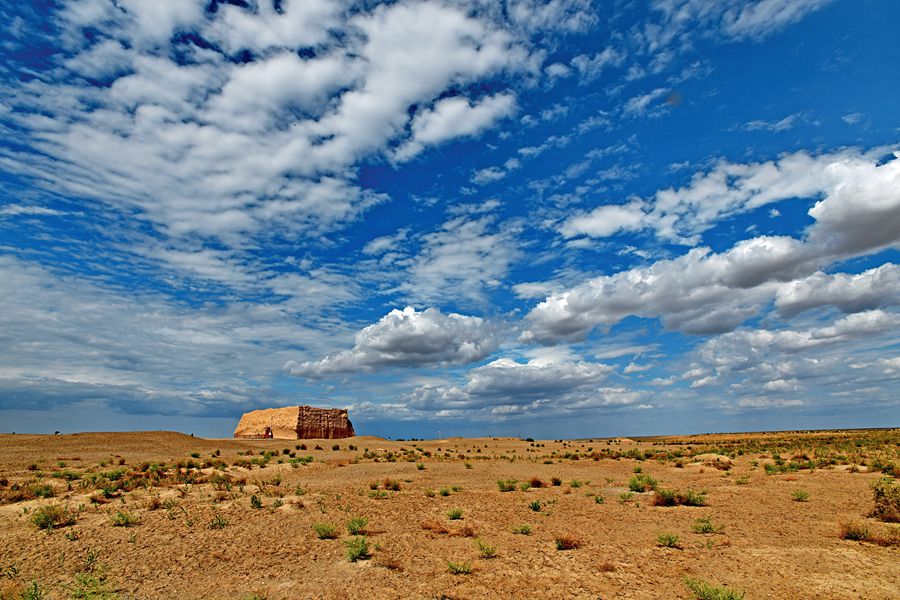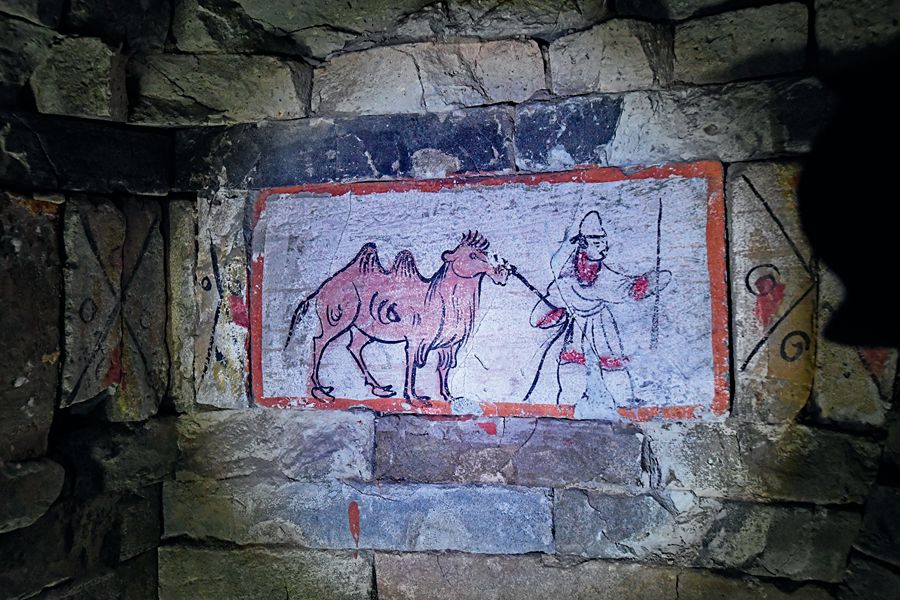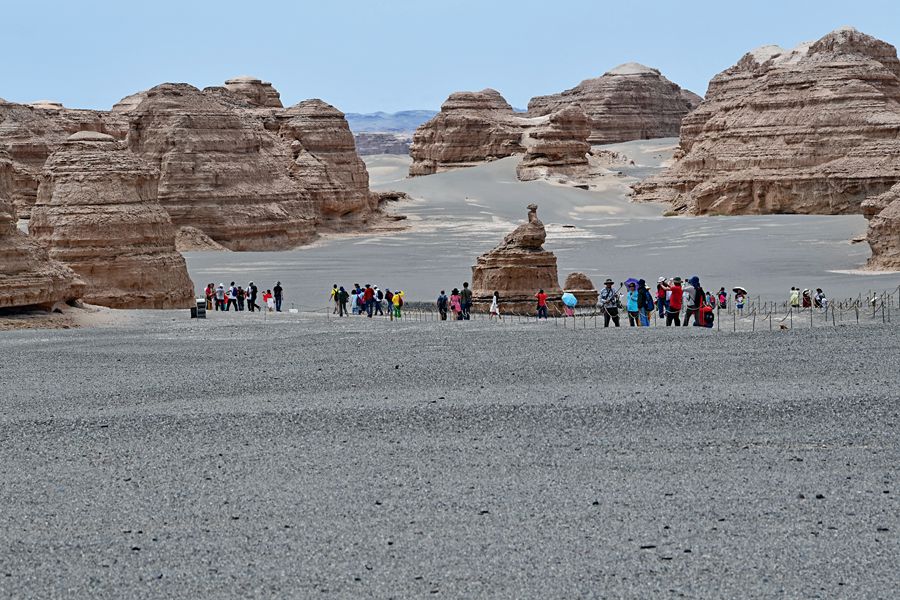YOU might be reading this article of China Today on printed paper, in Berlin, Paris, or Cairo, while I occasionally gaze through the glass pane of my Beijing office window while writing. Both would not have been possible without an old trade route that miraculously connected our worlds, Occident and Orient, almost two millennia ago.

In ancient times, Yumen Pass was a military stronghold along the Silk Road.
We are talking about the ancient Silk Road, a trade route that is surrounded by much mysticism and romance. It evokes tantalizing images of camel laden caravans riding into the sunset or lively, colorful exotic bazaars in your mind right now. In fact, the transport of goods via the bumpy ancient trade paths was often anything but romantic and led pack animals and merchants over long, impassable terrain through often hostile lands and weather to the limits of their resilience.
But from today’s point of view we know: in the end, the hardship paid off equally for traders and those who stayed at home, and certainly not just in material terms. As descendants, we still enjoy the fruits of this ancient, long-distance trade connection, often without being aware of it.
Gansu Province – A Cradle of the Historic Silk Road
To learn more about the legendary trade route it is best to go back to its place of origin. And this is best done where many impressive traits of the past can still be found today, namely in China’s northwest, or more precisely, in the province of Gansu.
Thus, I am heading for the city of Jiayuguan as my first stop. With 250,000 inhabitants, Jiayuguan is a small town by Chinese standards. However, its unique geographical location has given it a special place in history.

A mural in a tomb in Jiayuguan’s northeast suburb depicts a trader with his camel from Central and West Asia in his traditional garb.
Jiayuguan is located near the western end of the Hexi Corridor (or Gansu Corridor), a 1,000 km-long accumulation plain, acting as a natural passage leading from northwest to southeast, up to 100 kilometers wide, surrounded by high mountains from both north and south. On the south lies the snow-capped Qilian Mountain, a northern foothill of the Qinghai-Tibet Plateau, a range of hills which is essential for survival in the region.
Its meltwater feeds the two great rivers – Heihe, and Shule, which flow through the Hexi Corridor. They have ensured that numerous green oases and gradually larger settlements have formed here in the valley, between the otherwise barren desert and arid, parched landscape. One of the settlements is today’s Jiayuguan.

The Ghost City Yardang was ancient China’s north gate along the Silk Road leading to the Western Regions.
Photos by Yu Xiangjun
Located at the western tip of the Hexi Corridor, Jiayuguan forms a crucial bottleneck through which all travelers of the ancient Silk Road once had to pass on their way to today’s Xi’an (formerly Chang’an), the origin and terminus of the ancient trade route.
Jiayuguan owes its name to the Jiayu Pass, literally meaning “Pass to the Praised Valley,” which was once the westernmost transit point of the Great Wall. It was here that historic travelers from the West such as Marco Polo first set foot on their path to China’s inland regions.
There are still discernable clues and markers scattered around the area, which denote early and deep levels of interactions and exchanges beyond just business between the locals and the traders. To explore further, we head southwest, about 20 kilometers outside the city.
1,700-year-old Witnesses
In front of the bus window, a barren, inhospitable plain lies at the base of the mountains. For more than 1,700 years, there was an archaeological treasure buried beneath it, whose discovery in the early 1970s would open another small yet fascinating window into another facet of the illustrious history of the old Silk Road.
In 1972, locals came across traces of ancient masonry here. Finally, archaeological excavations were to dig up what today is celebrated as “the largest underground art gallery in the world.”
Here, under the rugged steppe, researchers identified a huge cemetery with 1,400 ancient tombs, which they dated to the time between the Wei and the Jin dynasties (220-420). So far only 18 of the graves have been excavated; two of them, graves number six and seven, are accessible to the public.
We feel our way down the narrow stone steps to tomb number six, a family tomb in which, according to the researchers, a senior official and his wife might have been buried once.
The 11-meter-high stone entrance wall alone reveals the impressive craftsmanship with which the tomb had once been decorated around the third century.
Figures in fairy tales, mythical creatures, as well as imagery of clouds, fire, and water were artfully carved into the red, ocher, and anthracite-colored bricks of the entrance. An even more splendid cultural treasure, however, lies hidden inside the tomb.
Tomb number six contains three narrow burial chambers arranged one behind the other over a length of 20 meters, each only about two meters wide. In the masonry of the vault, the original architects embedded a total of 136 painted brick stones, each of them decorated with vigorous brush strokes.
The region’s dry climate and the unusually slow oxidation that goes with it have ensured that the antique paintings are still astonishingly well preserved today, some 1,700 years after their creation. Such paintings have been found in eight of the excavated graves, a total of 760 illustrations have been discovered thus far.
The minimalist yet vibrant paintings in red-and-black on a white background show scenes from the everyday life of those now buried and therefore give a detailed insight into the everyday lives of the people and the state of affairs at the time. They show eating habits and everyday errands, but also leisure activities and cultural distractions thus painting a rare, unparalleled and detailed zeitgeist of the bygone era. The images tell of sowing and harvesting methods, ancient cattle breeding and hunting techniques, depict clothing styles, common means of transportation, musical instruments, and even old board games, as well as camel-ridden traders from Central and West Asia in their traditional garb, which impressively highlight the strong influences that the already lively trade via the Silk Road had at that time on the social and cultural life of the people. The tomb paintings show how the local intertwined with the foreign, and prove how the entire region reached a new intellectual and cultural awakening thanks to the flourishing trade.
More Than Just a Trade Route
In fact, as we now know, the old Silk Road was much more than a mere trade link.
In the second century B.C., the Han emperor Wudi, who commissioned the envoy Zhang Qian to explore the undeveloped areas beyond the Yumen Pass in the name of the imperial court, laid the formal foundations for the later network of routes that would connect three of the most important cultural regions of Asia at that time, namely the Persian Empire, India, and China.
After the previously isolated trade routes had been officially made accessible, secured, and extended for the first time under Emperor Wudi, they were to become the new arteries of exchange between the eastern and the western world in the course of the following centuries.
The largest volume of trade along the Silk Road was handled during the Tang Dynasty (618-907), especially in its first half. At that time China imported large quantities of gold, precious stones, ivory, perfumes, dyes, and textiles from the Occident. The Arabs meanwhile bought furs, ceramics, spices, jade, bronze, lacquerware, iron, and silk from the Chinese empire.
Silk in particular fascinated the people in the Western world, where it would be sold at high prices. This is one of the reasons why the German geographer, cartographer, and explorer Ferdinand Freiherr von Richthofen coined the name “Silk Road” for the route in his writings, a name that has attained legendary status and remains attributed to the route to present day.
But the exchange of goods was unintentionally accompanied by something else that was to have a lasting impact on our world: the transfer of technological developments, cultural exchanges, and new ideas.
Thus, glass goods and their advanced production techniques increasingly reached China from Arabia via the Silk Road. Meanwhile, the craftsmanship of paper production began its epoch-signifying march from China, first to the Arab world, and then all the way to Europe, where it was to give a decisive boost to the development of civilization.
However, unlike today, in the past, traders traveled with their goods, and so inevitably became intensively acquainted with the lives and everyday habits of people in the foreign countries that they passed through along their way, which made them became a forerunner of cultural exchanges.
Dunhuang – A Pearl of Buddhism
How deeply new ideas and spiritual innovations from afar took root in China can be witnessed in few places as impressively as in the city of Dunhuang, which lies at the western end of the Hexi Corridor near the border of Xinjiang Uygur Autonomous Region.
Dunhuang was originally established in 111 B.C. by Emperor Wudi of the Han Dynasty as a border post to defend the Chinese empire against external enemies. But soon Dunhuang became one of the most important trading hubs of the old Silk Road, as the northern and southern routes of the Silk Road converged here east of the Taklamakan Desert. Thus, Dunhuang developed into a melting pot of different cultures and religions and also became the gateway through which Buddhism for the first time found its way to China.
Today, the town, which has around 190,000 inhabitants, lives mainly off tourism. Visitors from all over the world come to visit the world-famous Mogao Grottoes, about 25 kilometers southeast of the city, which have been listed as a UNESCO World Heritage Site since 1987.
Between the 4th and 12th centuries, Buddhist monks dug around 1,000 caves into the sandstone rocks, which averaged 17 meters in height, adorned them with colorful Buddhist motifs, modeled huge Buddha statues from wood and clay, and painted filigree murals inside the caves.
After the decline of the old Silk Road, which began at the beginning of the Song Dynasty (960-1279), the cave system was forgotten for centuries before it returned to the international limelight thanks to the discovery of the Daoist priest Wang Yuanlu. Wang, in 1900, found about 50,000 documents from the 4th to 11th centuries that monks had walled into a cave in 1036, most probably to protect them from the marauding Mongol hordes.
The Mogao Grottoes are also called “Thousand Buddha Caves,” of which nearly half (492) have been well preserved; a part of them is accessible for tourists.
The caves were once used as decorative shrines for storing religious writings, among other things. The intricately artistic paintings inside were also designed to facilitate meditation and served as visual representations of the sutras and thus as descriptive mnemonics of Buddhist stories, which were also intended to give illiterate people an introduction to Buddhist teaching.
North Indian Buddhism, along with local philosophies such as Taoism and Confucianism, rose to become one of China’s three traditional main religious beliefs, reflecting early intellectual openness of Chinese thought to foreign ideas.
Decline and Rebirth
Increased Chinese sea trade, the emergence of new markets in Southeast Asia, rising customs requirements of the Arabs, and dwindling rivers around the Taklamakan and Lop Nor deserts in the middle part of the Silk Road finally heralded the decline of the terrestrial Silk Road around the middle of the 10th century.
In the 21st century, trade tends to build much less intensive personal bridges than it did in the past. Today, ships are loaded by Chinese workers in China and unloaded by local counterparts in the United States or Europe and vice versa. The goods therefore travel without their traders and thus without the previously unavoidable mutual immersion in respective foreign cultures.
However, in modern times, a new business has opened up that still gives us the opportunity to follow in the footsteps of the old business travellers – international tourism. Those in charge in Jiayuguan and Dunhuang also recognized its potential, and this year for the eighth time, organized an international tourism festival.
Even in the age of the Internet, it is still worthwhile to return to the exploratory spirit of the old merchants of the Silk Road. It is worth it to travel thousands of kilometers to distant regions in person in order to get interact directly with the locals and their customs and to let their foreign culture have a personal effect on us, as well as to absorb their thoughts and habits. In this way we might eventually take at least a part of it home with us, just like the Silk Road merchants did in the old times, and who knows, perhaps something completely new will emerge from it in our lives and countries, which will be recorded in the history books of the future.


